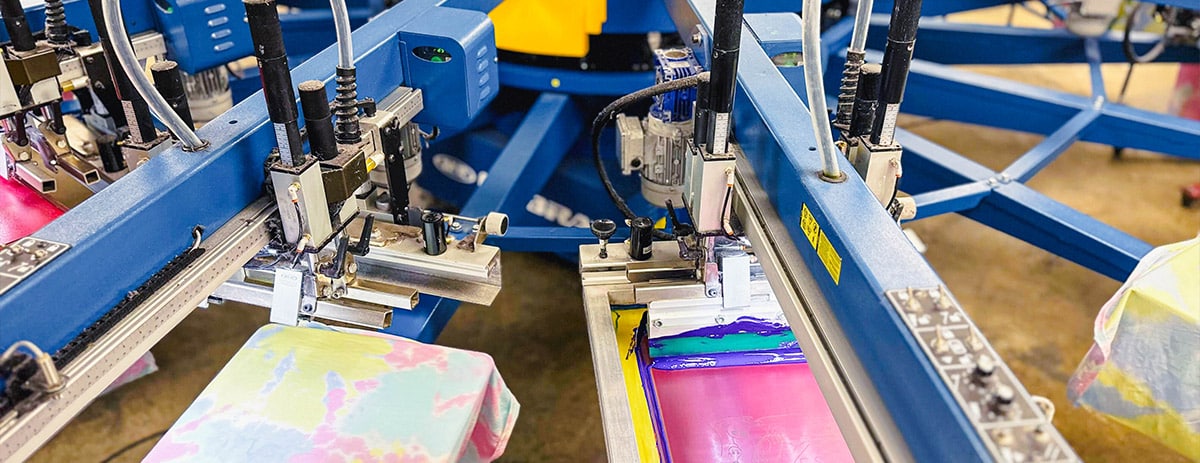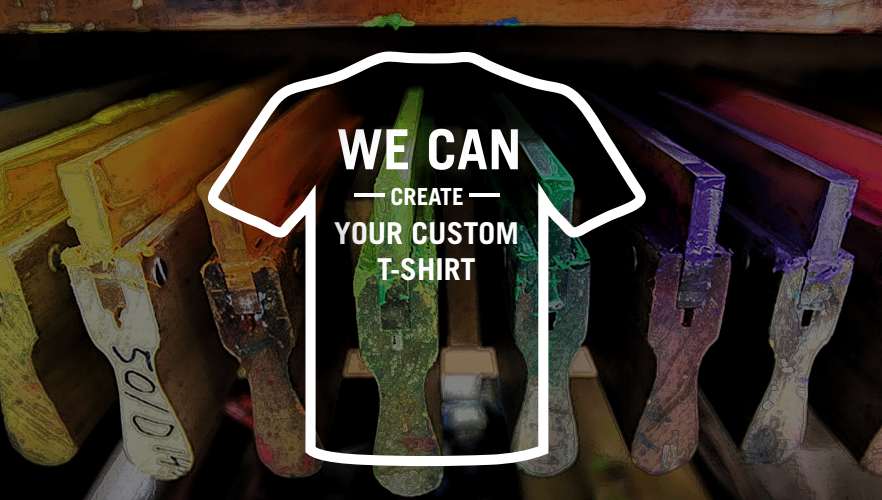Affordable Custom Screen Printing Services for Small Businesses
Affordable Custom Screen Printing Services for Small Businesses
Blog Article
Display Printing Uncovered: Whatever You Need to Know About Tee and Garment Printing Strategies
Screen printing is a fascinating approach that combines art with method, providing endless possibilities for imagination. All set to check out the necessary elements that make screen printing an art kind?
The Fundamentals of Screen Printing: Exactly How It Works
When you plunge into screen printing, you'll find it's both a science and an art. At its core, display printing entails creating a pattern, or screen, that allows ink to pass with only in particular locations.
Following, you'll blend your inks and prepare your printing surface area. Position the display over the textile, after that make use of a squeegee to push ink with the screen onto the garment. This process calls for accuracy, as you desire clear, vibrant prints. After printing, you'll treat the ink with heat, ensuring it adheres to the material and lasts via washes. Each step is vital, and grasping them will certainly raise your screen printing skills, changing straightforward garments into distinct, meaningful pieces.
Sorts Of Display Printing Strategies
Once you comprehend the fundamentals of screen printing, it's time to explore the different techniques that can raise your layouts. One popular approach is typical screen printing, where ink is pressed through a stenciled display.
An additional choice is plastisol printing, understood for its durability and vibrant shades, making it a favored for numerous brands. Experiment with halftone printing to produce slope results and elaborate designs.
Essential Tools for Screen Printing
To achieve sensational outcomes in display printing, having the best tools is essential. You'll need a strong display printing framework, which holds the mesh that moves your style onto the garment. Next, purchase high-quality mops; these are vital for using ink equally throughout the screen. You'll likewise need a good exposure device to develop your screens, in addition to a washout booth for cleaning them after usage. A trusted warmth source, like a conveyor dryer or warmth press, is crucial for curing your prints to guarantee durability. Do not forget an appropriate work area, furnished with tables and storage space for your supplies. Finally, safety equipment, such as masks and handwear covers, will certainly maintain you safe from chemicals and inks. With the right devices, you'll be well on your way to generating professional-quality prints.
Picking the Right Inks and Products
When choosing inks and products for display printing, you require to think about the kind of ink that functions best for your project. Think about material compatibility to ensure your designs look last and great lengthy. Discover environment-friendly ink options to make your printing procedure more sustainable.
Kinds Of Display Inks
Picking the ideal screen ink is crucial for achieving dynamic, long lasting prints that meet your project's requirements. There are a number of kinds of display inks to check out. Plastisol ink is popular for its adaptability and simplicity of use, offering excellent color opacity on dark fabrics. Water-based ink, on the various other hand, provides a softer feel and is green, making it perfect for those wanting to lessen their environmental effect. Release inks eliminate dye from the textile, leading to a soft, classic appearance yet require particular handling. Specialized inks, such as glow-in-the-dark or metal, can include unique results to your layouts. Review your task needs and choose the ink that lines up best with your desired end result.

Fabric Compatibility Factors To Consider
Comprehending material compatibility is vital for achieving top notch display prints, especially because different products respond uniquely to different inks. When picking inks, consider the textile kind-- cotton, polyester, or blends. For cotton, water-based inks work well, supplying soft qualities and breathability. Polyester, on the other hand, usually calls for plastisol inks for much better adhesion and vivid colors. If you're publishing on blends, you may require to make use of a combination of both kinds. Always examine your inks on sample textile to assure they stick properly and keep shade stability. In addition, bear in mind that material weight and structure can impact the final outcome, so choosing the right ink and material combination is crucial for your task's success.
Eco-Friendly Ink Options
Environmentally friendly inks are ending up being a popular choice for display printers that desire to decrease their ecological influence while maintaining quality. When selecting inks, think about water-based inks, which are much less damaging and easier to cleanse up contrasted to traditional solvents.
In addition, seek inks made from renewable energies, such as soy or vegetable-based choices. By choosing the ideal inks and products, you'll not only create stunning styles yet also add to an extra sustainable printing procedure. Make the button, and your prints will certainly reflect your commitment to the atmosphere!
Preparing Your Style for Display Printing

Submit Layout Requirements
To ensure your design looks sharp and vibrant on material, you'll require to pay close attention to file format requirements for screen printing. Make sure your layout has a transparent background to protect against unwanted white edges on your prints. Keep shade modes in mind; CMYK is common for screen printing, so transform your RGB creates as necessary.
Color Separation Strategies
Color splitting up is a crucial action in preparing your design for screen printing, and mastering it can significantly improve your print high quality. You'll require to break your layout into private shades, as each shade needs a separate display during printing. This accuracy not just guarantees exact shade representation yet likewise simplifies the printing process.
Resolution and Dimension
Achieving the most effective lead to display printing starts with ensuring your layout has the ideal resolution and size. Ideally, your art work needs to go to least 300 DPI (dots per inch) find out for sharp, clear prints. Your last item might look unprofessional and pixelated. if you use lower resolution.
When it concerns dimension, consider the dimensions of your print location. Layout your artwork to match the last print dimension, ideally developing it in the real dimensions you'll be printing. By doing this, you'll avoid any kind of unexpected scaling problems.
Always examine your layout in both vector and raster formats. Vector graphics can be scaled without losing quality, making them optimal for display printing. Preparing correctly will guarantee your style looks outstanding on every garment!
Step-by-Step Screen Printing Refine
Screen printing is a dynamic process that allows you to produce vibrant layouts on different surface areas. To obtain started, you'll require a display, solution, and your selected ink. Prepare your screen by cleaning it extensively. Next, use the emulsion equally and let it completely dry in a dark area. As soon as completely dry, subject your display to light with your design positioned on it, which will certainly set the emulsion where the light hits, creating a stencil he said - screen printing kit.
After washing out the unexposed solution, your screen prepares. Establish it up on your printing surface area and align your garment beneath it. Put ink onto the screen and use a squeegee to push the ink through the pattern onto the fabric. Raise the screen carefully and let the print completely dry. Finally, treat the ink utilizing heat to assure sturdiness. That's it! You have actually effectively screen published your style.
Tips for Successful Screen Printing Projects
While you're diving into your display printing tasks, bear in mind that prep work is essential to success. Start by collecting all your products-- inks, screens, garments, and squeegees. A tidy work space assists avoid unwanted errors, so clean up before you start.
Next, validate your artwork is high-resolution and properly sized for your garment. Test your display for proper exposure and tidy it extensively to prevent spots. When mixing your inks, comply with the manufacturer's standards to achieve the appropriate consistency.
During printing, use also pressure with your squeegee for constant outcomes. Do not rush; take your time to verify each print meets your requirements. After printing, allow your garments dry totally before dealing with or packaging them.
Finally, constantly maintain a sample of your help future reference. In this manner, you can evaluate your progression and improve your strategies over time. Happy printing!

Often Asked Concerns
For how long Does It Require To Establish up a Display Printing Job?
Establishing a display printing task usually takes around half an hour to an hour. You'll prepare the screens, mix inks, and readjust journalism. The time varies based on complexity and experience, so stay organized!
Can I Print on Different Fabric Keys In Making Use Of the Exact Same Strategy?
Yes, you can publish on various textile kinds making use of the very same strategy, yet you'll require to readjust your settings and inks. Some fabrics absorb ink in a different way, so experimenting guarantees the most effective outcomes for every material.
What Prevail Blunders to Prevent in Display Printing?
When display printing, avoid typical mistakes like using the incorrect ink, ignoring correct exposure times, or missing pre-press checks. Constantly test your setup and keep clean displays to ensure top quality outcomes each time.
How Can I Properly Tidy and Keep My Screen Printing Tools?
To effectively tidy and keep your screen printing tools, you ought to routinely wash displays with proper solvents, check mops for wear, and guarantee all devices are kept dust-free and completely dry. Consistency enhances and prevents costly fixings wikipedia reference performance.
Is Display Printing Eco-friendly Compared to Other Approaches?
Screen printing can be a lot more eco-friendly than other approaches, particularly if you utilize water-based inks and eco-conscious products. By choosing sustainable supplies and techniques, you reduce waste and lessen your impact on the earth.
Display Printing Uncovered: Everything You Need to Know About Tee Shirt and Garment Printing Techniques
At its core, screen printing involves creating a pattern, or screen, that permits ink to pass via just in particular locations. Setting the screen over the fabric, then use a squeegee to push ink with the screen onto the garment. One popular approach is conventional display printing, where ink is pressed through a stenciled screen.When choosing inks and materials for display printing, you need to take right into account the type of ink that functions best for your task.
Report this page